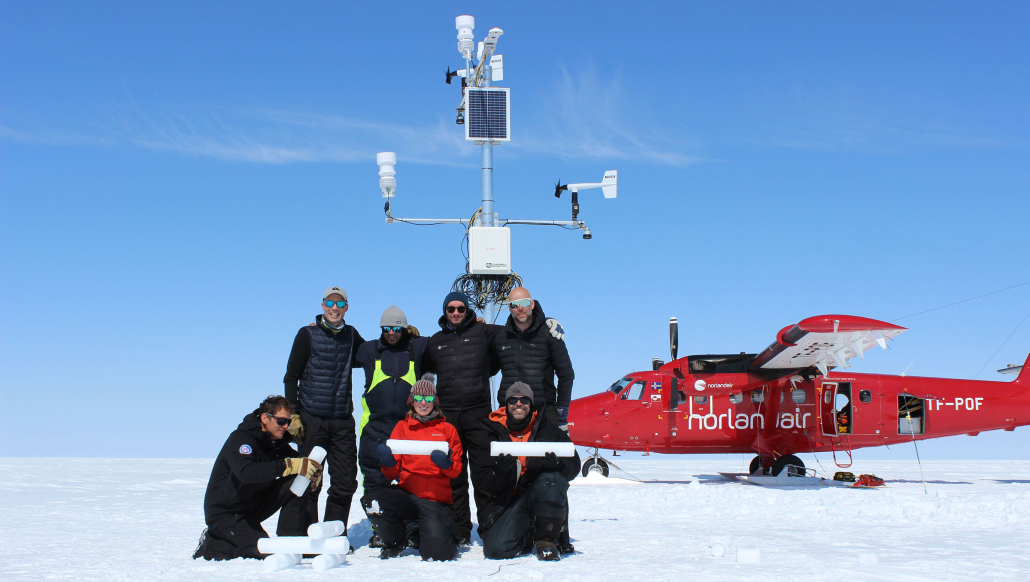The Greenland Ice Sheet has receded 27 years in a row
Scientists monitoring the Greenland Ice Sheet can copy-paste the conclusion of the result of this year’s melting season into the reports for the 27th year in a row.
Often, it’s nice to be able to reuse your work and save some time, but no one is excited to be able to copy their old status in this case, as the Greenland Ice Sheet that has shrunk for the 27th year in a row. This is shown by the continuous monitoring of the Greenland Ice Sheet.
In this year’s melting season, the Greenland Ice Sheet has shrunk by approximately 200 gigatons. You might ask yourself if that is a lot. Or even better, you can ask a relevant researcher, such as Robert S. Fausto, who is a Senior Researcher at the Department of Glaciology and Climate at the Geological Survey of Denmark and Greenland (GEUS) and works with monitoring of the Greenland Ice Sheet under the monitoring programmes PROMICE and GC-Net.
”200 gigatons sounds like a lot, but it is not a large part of the total volume of the Greenland Ice Sheet, and as an isolated case it is not worrying in itself. The worrying thing is that it is the 27th year in a row that we register that the total volume of the ice sheet is decreasing,” says Robert S. Fausto.
Mass balance is the key to understanding the size of the Greenland Ice Sheet
The Greenland Ice Sheet is not a constant and unchanging quantity – it is dynamic and changes over time, even over a relatively short period of time, such as a year. This is because it is affected by a number of processes, such as the supply of new snow and melting.
Andreas P. Ahlstrøm, Chief Consultant at GEUS, elaborates:
“Every year, we measure the amount of snowfall that contributes to the growth of the ice sheet, but this process is also changing. It happens more often now that the snow falls as rain, even high up on the ice sheet. Some years, the amount of meltwater that refreezes in the snow has been so extensive that it has created sheets of ice that stick together. And this causes subsequent years’ meltwater to run out to sea because it cannot penetrate the packed snow.”
Every year, the researchers in PROMICE and GC-Net take stock of the Greenland Ice Sheet by comparing the year’s current measurements with previous years’ measurements and with the average for the period 1991-2020. If the current year’s measurement is below average, this is not alarming in itself – the clever reader may notice large fluctuations in the individual year’s measurements in the graph below. This is to be expected.
What is worth noting is that the last 27 years of measurements have all shown that the Greenland Ice Sheet has receded.
It is easy to see in the graph below showing the total loss of mass over time.
The medical record is an important step on the way to a cure
If you are ill, a doctor ascertains what the symptoms are, and then decides what the treatment should be. Robert S. Fausto compares the researchers’ monitoring of the Greenland Ice Sheet to a nurse’s work. The researchers note the symptoms of the Greenland Ice Sheet, and then pass on the medical records.
“I usually say that we are the nurses who look after the patient: the Greenland Ice Sheet. Now we have been on the ward for many years in a row, and for the past 27 years we have been able to ascertain that this thing is happening to the patient. It shrinks and we have numbers that show it. It is now up to the doctors and the hospital director to prioritise the cure and the resources required to bring the ice sheet into balance,” says Robert S. Fausto.
Where does the water go?
The melting of the Greenland Ice Sheet affects the sea level globally. As a look at a globe will reveal, the large world oceans and the two large ice masses, the Greenland Ice Sheet and the even larger ice mass that makes up Antarctica, are connected.
When the Greenland Ice Sheet melts, it can cause seas to rise elsewhere in the world. Land masses around the equator will experience the greatest rise, because the water will go there due to the Earth’s shape and gravity. But this does not mean that only countries around the Equator that will experience a rise in sea level. If the entire Greenland Ice Sheet melts away, it could contribute to a global sea level rise of up to seven metres.

Researchers posing with some samples of the ice. (Photo: GEUS).
 GEUS
GEUS Wally and Fauland
Wally and Fauland